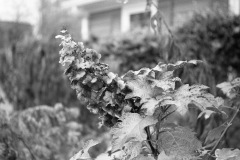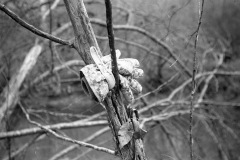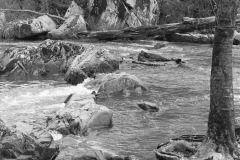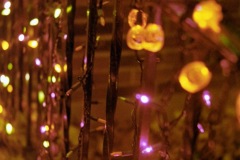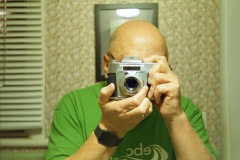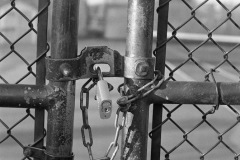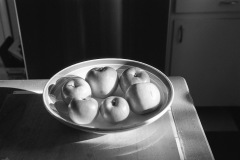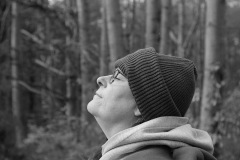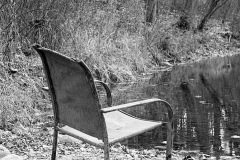An SLR from the end of the 1950s. In great cosmetic and (mostly) working condition. $34. Who could resist?
During a visit to UsedPhotoPro last fall, I came upon an Agfa Agfaflex, a West German-built SLR with a non-interchangeable 50 f2.8 lens in working condition. I’ve long respected old German cameras — I have several working Voitlanders, a Minox and Wirgin rangefinder — and Agfa was one of my favorite films (really miss my Vista!), so I decided to give the camera a try.
The Agfaflex (known as Colorflex in markets outside of the U.S.) is a very solid piece of gear, weighing in at just over two pounds (!). It’s all metal, feels great in the hand and is a joy to look at. Unlike most SLRs, the Agfaflex I/II does not have interchangeable lenses, but instead features a 50mm 2.8 Color Apotar lens that’s permanently fixed to the body. List price from 1960 catalog: $129.95 (about $1300 today!)
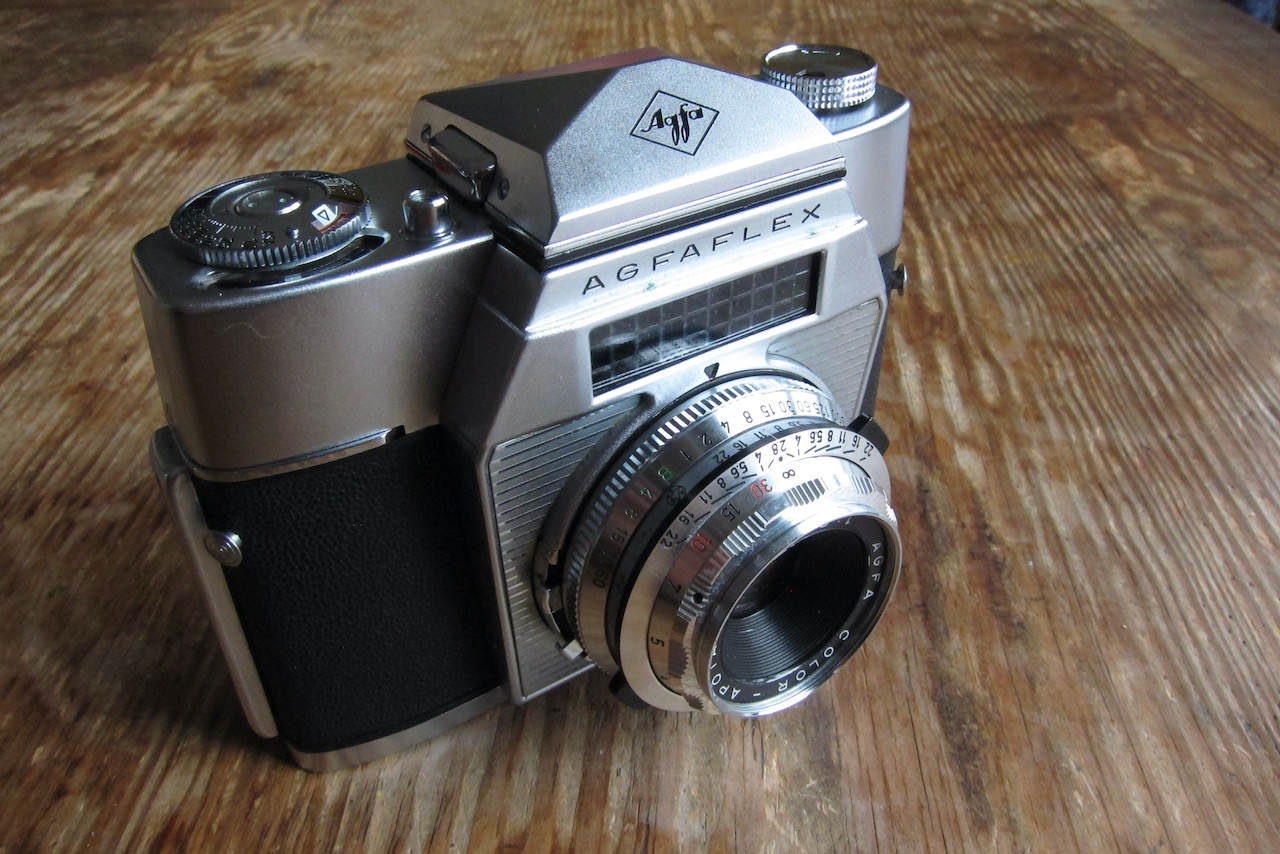 While the lens isn’t interchangeable, the prism is. My copy is technically an Agfaflex II, with an eye-level prism finder. The Agfaflex I featured a waist-level finder. The finders on these models could be swapped, depending on your shooting style. There were later models called (naturally) the Agfaflex III and IV, which were similar models but with interchangeable lenses.
While the lens isn’t interchangeable, the prism is. My copy is technically an Agfaflex II, with an eye-level prism finder. The Agfaflex I featured a waist-level finder. The finders on these models could be swapped, depending on your shooting style. There were later models called (naturally) the Agfaflex III and IV, which were similar models but with interchangeable lenses.
The viewfinder is big and bright with a ground glass focusing screen. The Agfaflex has a split-image rangefinder to assist with focusing — line up the two halves of the focusing circle and your image is in focus. The focus ring is on the front of the lens; it turns smoothly, but with a bit of heft. There is no data shown in the viewfinder…that’s all external. The viewfinder is also at full aperture — the lens doesn’t close down until the photo is taken — so it is very bright. The focus ring has a field of view scale, too.
The Afgaflex has a selenium-cell light meter that does not require batteries. Many selenium cell meters fade with age and stop working all together. My camera’s meter works…sometimes. It’s a pretty good bet this was kept in the dark for most of its life.
The meter window is on the top of the camera, while the light-gathering bits are right above the lens. When pointed at your source, the needle on the meter moves. Again, mine works sometimes; when it does, it’s pretty accurate. When it doesn’t, I use my phone app to measure light.
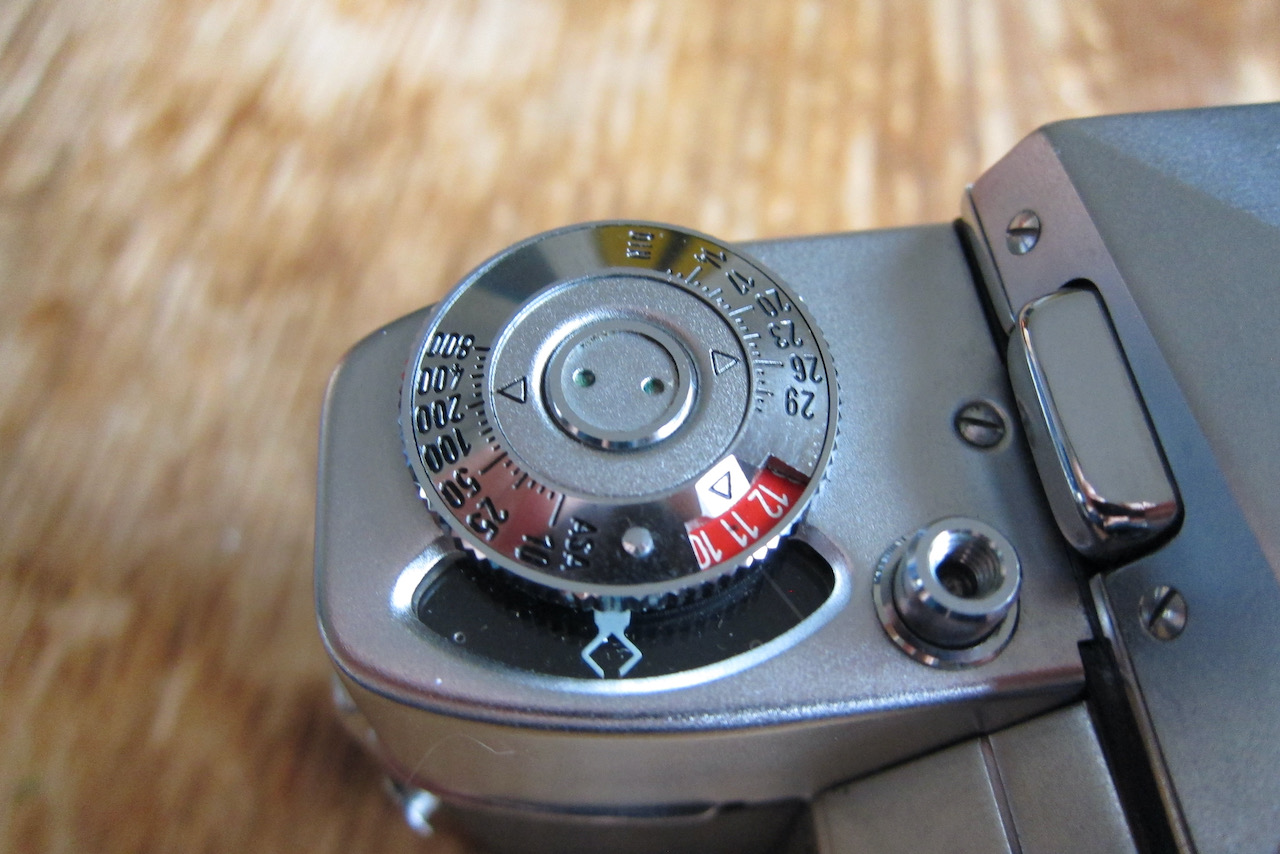 Next to the meter window is a milled ring. When loading the camera, you set the ASA (read: ISO) using a sliding knob. To take a reading, you match the frame marker over the meter needle by turning the milled ring. When lined up, the number indicates the Exposure Value (EV; from 2 to 18). Using this number, you can then set exposure. And if the meter isn’t working, the phone app light meter I use also provides an EV number, which lines up with the system this camera uses.
Next to the meter window is a milled ring. When loading the camera, you set the ASA (read: ISO) using a sliding knob. To take a reading, you match the frame marker over the meter needle by turning the milled ring. When lined up, the number indicates the Exposure Value (EV; from 2 to 18). Using this number, you can then set exposure. And if the meter isn’t working, the phone app light meter I use also provides an EV number, which lines up with the system this camera uses.
The Agfaflex has a neat system to set that exposure. Around the lens are the shutter speed and aperture settings, along with a ring with number from 2 to 18. The numbers in red on this ring indicate EV. Pressing the two black levers on this ring and moving the indicator to the number taken from the meter reading sets exposure.
 For example, if you set the indicator at 14, it will set the aperture to f8 and shutter speed to 250. These rings are now locked together; as you move it, it keeps the ratio of the two the same, so you can set an aperture of 16 and the corresponding shutter speed will be 125. Brilliant!
For example, if you set the indicator at 14, it will set the aperture to f8 and shutter speed to 250. These rings are now locked together; as you move it, it keeps the ratio of the two the same, so you can set an aperture of 16 and the corresponding shutter speed will be 125. Brilliant!
The shutter is a Prontor-Reflex type, with speeds from 1/300 down to 1 second and Bulb. Unlike most modern SLRs, the shutter is actually in the lens, not behind the mirror. When you press the shutter button, the mirror moves up out of the way, the aperture in the lens closes to its set level and the leaf shutter blades do their thing. The aperture stays at the set closure and the mirror stays up (you can’t see anything through the viewfinder) until you advance the film and cock the shutter. It’s an interesting shooting experience to say the least. But remember, this was from 1959 — more than six decades ago — and camera makers were still figuring out what an SLR could do.
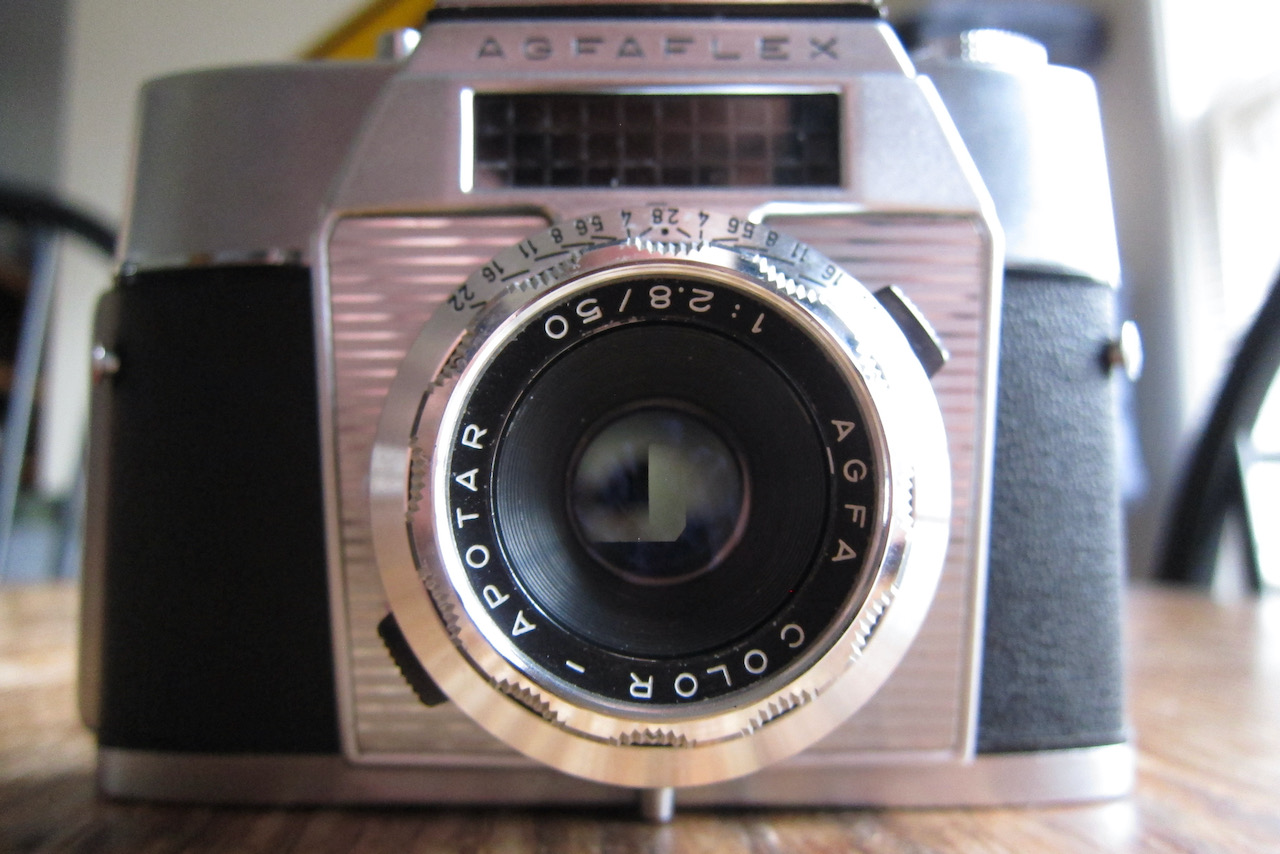 The shutter sound on the Agfaflex is music to my ears. it is a very satisfying click clunk, but it is smooth, as the mirror doesn’t slap back down during the exposure. The winder lever is smooth, too, with a bit of heft, as it’s not only re-cocking the shutter but also opening the aperture wide and bringing the mirror down.
The shutter sound on the Agfaflex is music to my ears. it is a very satisfying click clunk, but it is smooth, as the mirror doesn’t slap back down during the exposure. The winder lever is smooth, too, with a bit of heft, as it’s not only re-cocking the shutter but also opening the aperture wide and bringing the mirror down.
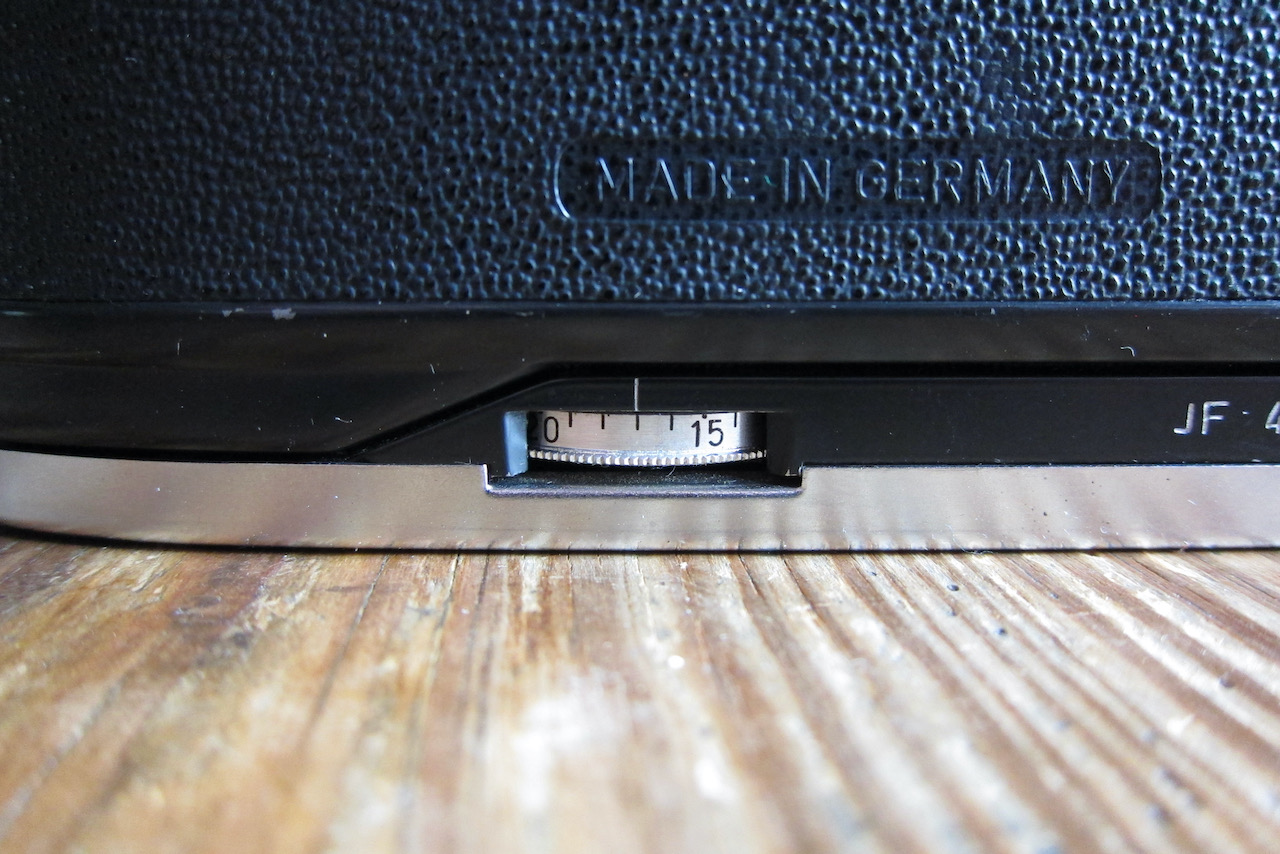 The frame counter on this camera is on the lower back, right in the middle. It doesn’t automatically reset when you open the back — it needs to be manually reset when you insert a new roll. There are marks on the counter wheel for 20 or 36 (back then, rolls of film were 20 or 36 exposure, not the 24 and 36 we are used to today). While there’s no tab on the back for a film box top reminder, there is an indicator on the film rewind knob on top for B&W, color negative and three different slide films (incandescent, daylight flash and daylight).
The frame counter on this camera is on the lower back, right in the middle. It doesn’t automatically reset when you open the back — it needs to be manually reset when you insert a new roll. There are marks on the counter wheel for 20 or 36 (back then, rolls of film were 20 or 36 exposure, not the 24 and 36 we are used to today). While there’s no tab on the back for a film box top reminder, there is an indicator on the film rewind knob on top for B&W, color negative and three different slide films (incandescent, daylight flash and daylight).
Loading the film is a simple matter, essentially like any other camera. However, the Agfaflex’s back opens on the right side of the camera (the only one of mine that does) via a latch in the lower right corner. Rewinding the film when done is a little arduous — there’s no flip up handle that you get on most SLRS — so you need to turn the rewind knob manually. Takes about three times as long as it does with, say, my Nikon FG, but it does the trick.
I enjoy shooting this camera. Its heft is a plus for me — it feels very solid. Taking a photo is a three or four step process: check the meter, determine the EV, set the number on the lens, then choose what aperture/shutter combo you want to use. If the meter isn’t working, my Pocket Light Meter app on my phone provides an EV number that works fine. Then focus, and shoot.
Close focus is 3.5 feet; on a 50mm lens, that’s close enough to fill the frame with a head shot. One thing I do notice is that given how the lens is set up and the small size of the focus ring, some of my photos, especially those in portrait orientation, end up with a flesh-colored blob in the corner. Yep, my hands get in the way.
The lens produces sharp images for a 60-plus year old camera; some of the bokeh can be a little swirly, but it is a neat look. I would not consider this a contrasty lens, especially when shooting color, but overall, I like the images I’ve made so far.
All in all, I’m very happy with this $30 purchase. The Agfaflex is a joy to look at, a fun experience to shoot and mechanical marvel from the dawn of the SLR. Plus, that little emboss on the back leatherette — “Made In Germany” — is a plus.
To learn more about this gem, I’d suggest leafing through the manual (available on Mike Butkus’ Orphan Cameras site…a treasure trove of vintage camera goodness!). The manual is highly detailed and very well written, a fun read on its own! See it here: https://www.cameramanuals.org/agfa_ansco/agfaflex_i_ii.pdf



